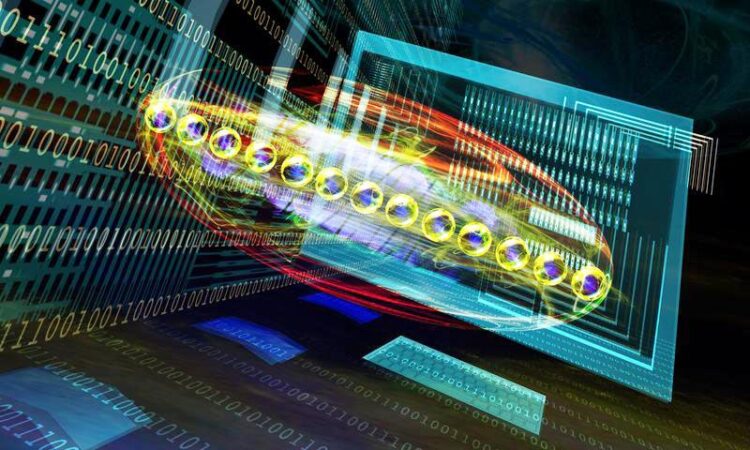Quantum simulation: Measurement of entanglement made easier

Bei dem neuen Verfahren wird der Quantenzustand des Quantensimulators auf einem klassischen Computer aus wenigen Messungen rekonstruiert.
Harald Ritsch / IQOQI Innsbruck
Researchers led by quantum physicist Peter Zoller have developed a method to make previously hardly accessible properties in quantum systems measurable. The new method for determining the quantum state in quantum simulators reduces the number of necessary measurements and makes work with quantum simulators much more efficient.
In a few years, a new generation of quantum simulators could provide insights that would not be possible using simulations on conventional supercomputers. Quantum simulators are capable of processing a great amount of information since they quantum mechanically superimpose an enormously large number of bit states.
For this reason, however, it also proves difficult to read this information out of the quantum simulator. In order to be able to reconstruct the quantum state, a very large number of individual measurements are necessary. The method used to read out the quantum state of a quantum simulator is called quantum state tomography.
“Each measurement provides a ‘cross-sectional image’ of the quantum state. You then put these cross-sectional images together to form the complete quantum state,” explains theoretical physicist Christian Kokail from Peter Zoller’s team at the Institute of Quantum Optics and Quantum Information at the Austrian Academy of Sciences and the Department of Experimental Physics at the University of Innsbruck. The number of measurements needed in the lab increases very rapidly with the size of the system. “The number of measurements grows exponentially with the number of qubits,” the physicist says. The Innsbruck researchers have now succeeded in developing a much more efficient method for quantum simulators.
Efficient method that delivers new insights
Insights from quantum field theory allow quantum state tomography to be much more efficient, i.e., to be performed with significantly fewer measurements. “The fascinating thing is that it was not at all clear from the outset that the predictions from quantum field theory could be applied to our quantum simulation experiments,” says theoretical physicist Rick van Bijnen. “Studying older scientific papers from this field happened to lead us down this track.” Quantum field theory provides the basic framework of the quantum state in the quantum simulator. Only a few measurements are then needed to fit the details into this basic framework.
Based on this, the Innsbruck researchers have developed a measurement protocol by which tomography of the quantum state becomes possible with a drastically reduced number of measurements. At the same time, the new method allows new insights into the structure of the quantum state to be obtained.
The physicists tested the new method with experimental data from an ion trap quantum simulator of the Innsbruck research group led by Rainer Blatt and Christian Roos. “In the process, we were now able to measure properties of the quantum state that were previously not observable in this quality,” Kokail recounts.
Verification of the result
A verification protocol developed by the group together with Andreas Elben and Benoit Vermersch two years ago can be used to check whether the structure of the quantum state actually matches the expectations from quantum field theory. “We can use further random measurements to check whether the basic framework for tomography that we developed based on the theory actually fits or is completely wrong,” explains Christian Kokail. The protocol raises a red flag if the framework does not fit. Of course, this would also be an interesting finding for the physicists, because it would possibly provide clues for the not yet fully understood relationship with quantum field theory. At the moment, the physicists around Peter Zoller are developing quantum protocols in which the basic framework of the quantum state is not stored on a classical computer, but is realized directly on the quantum simulator.
The research was financially supported by the Austrian Science Fund FWF and the European Union, among others.
Wissenschaftliche Ansprechpartner:
Christian Kokail
Institute of Quantum Optics and Quantum Information
Austrian Academy of Sciences
phone +43 512 507 4796
email: christian.kokail@oeaw.ac.at
web: https://iqoqi.at/
Originalpublikation:
Entanglement Hamiltonian Tomography in Quantum Simulation. Christian Kokail, Rick van Bijnen, Andreas Elben, Benoit Vermersch, and Peter Zoller. Nature Physics 2021. doi: 10.1038/s41567-021-01260-w https://www.nature.com/articles/s41567-021-01260-w
Media Contact
All latest news from the category: Physics and Astronomy
This area deals with the fundamental laws and building blocks of nature and how they interact, the properties and the behavior of matter, and research into space and time and their structures.
innovations-report provides in-depth reports and articles on subjects such as astrophysics, laser technologies, nuclear, quantum, particle and solid-state physics, nanotechnologies, planetary research and findings (Mars, Venus) and developments related to the Hubble Telescope.
Newest articles

First-of-its-kind study uses remote sensing to monitor plastic debris in rivers and lakes
Remote sensing creates a cost-effective solution to monitoring plastic pollution. A first-of-its-kind study from researchers at the University of Minnesota Twin Cities shows how remote sensing can help monitor and…

Laser-based artificial neuron mimics nerve cell functions at lightning speed
With a processing speed a billion times faster than nature, chip-based laser neuron could help advance AI tasks such as pattern recognition and sequence prediction. Researchers have developed a laser-based…

Optimising the processing of plastic waste
Just one look in the yellow bin reveals a colourful jumble of different types of plastic. However, the purer and more uniform plastic waste is, the easier it is to…


